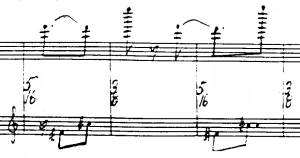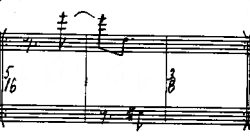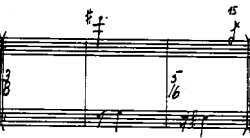As I noted at the end of the last installment of my trek through For Bunita Marcus, the end of page 19 signals something altogether different:
 I think of this almost like a fanfare (although scaled within a Feldman context!), an announcement of someone new coming through the doorway. What happens over the next three pages is an expansion of time and a sharpening of concentration in the piece. It is as if the appearance of a new imagery settles the heart of the music. It becomes intensely focused on simple things, where even tiny changes seem momentous.
I think of this almost like a fanfare (although scaled within a Feldman context!), an announcement of someone new coming through the doorway. What happens over the next three pages is an expansion of time and a sharpening of concentration in the piece. It is as if the appearance of a new imagery settles the heart of the music. It becomes intensely focused on simple things, where even tiny changes seem momentous.
The initial musical image here is a static sonority that is activated from within by the placement of attacks. The sonority shown in the example above—the four tones in those specific registers—is sustained over the next system or so of music, but with the order and rhythm of the four attacks shifting:
Once the image is sustained, Feldman shifts it slightly, first by dropping the F-sharp:
And then by bringing the E down to a D-sharp and moving the D up to an E, plus adding a grace-note F-natural:
He then sustains this new sonority for another page’s worth of music. The rhythms of the patterns have slowed down, and this, combined with the subtle variations, makes the whole thing float: we can’t latch onto any obvious rhythmic pattern, and so we really keep track of exactly what’s happening. Sonically the music is static, like the passage on pages 8-10, but rhythmically it’s much more spacious, so the feeling is different. This is another case of Feldman’s reflections, as I have called them: neither repetition nor development, but a way of dwelling upon an image that has energy and change but not necessarily direction.
Midway through page 21, Feldman takes us out of this space and the opening “fanfare” returns for a few repetitions. The music then settles again into a new reflection on a new image: from the patterns we’ve been hearing, Feldman draws out a simple two-note phrase. The next page and a half (through the end of page 22) is devoted to these, generally presented in pairs with a measure’s rest between them and repeated:
At this point the music has settled and become very quiet (energetically, not just in terms of volume). The long pauses between the two-note phrases slows the pace and sets off each phrase so that we can hear them very clearly. Our attention is focused more and more closely on each of these as they occur; our awareness is narrowed more and more to the present moment. At the end of the page, the music almost literally floats away:
The first time I started playing this section, I found the whole thing exhilarating, and on days when my energy and attention are strong, I still get into a kind of “zone” in these pages. It very much feels like a turning point in the piece, like something has been discovered. It also makes you wonder when it will end, and where the music will go next.





